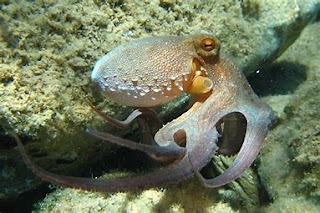Octopus have some interesting facts that you may don't know. The facts are
1. Octopus have three hearts and blue blood:
Octopus have three hearts. Two of the hearts work exclusively to move blood beyond the animal's gills, while the third keeps circulation flowing for the organs. When the Octopus swims, the organ heart stops beating, which explains why these prefer to crawl rather than swim( it exhausts them).
Unlike vertebrates that have iron-rich hemoglobin packed into red blood cells, Octopuses - along with some tarantulas, scorpions and horseshoe crabs- have copper -rich hemocyanin dissolved directly in their blood (this means their blood is blue).
Hemocyanin is less efficient than hemoglobin as an oxygen transporter. The three hearts help to compensate for this by pumping blood at higher pressure around the body to supply the Octopus's active lifestyle.
2. Octopus have nine brains:
The Octopuses have nine brains. A central brain controls the nervous system. In addition, there is a small brain in each of their eight arms -- a cluster of nerve cells that biologists say control movement. This allows the arms to work independently of each other, yet together toward the same goal.
He Octopus has the highest brain to body mass ratio of all invertebrates; it is also greater than that many vertebrates. It has a highly complex nervous system, only part of which is localised in it's brain, which is contained in a cartilaginous capsule. Two-thirds of an Octopus's neurons are found in the nerve cords of its arms.
For content like this go through here.






No comments